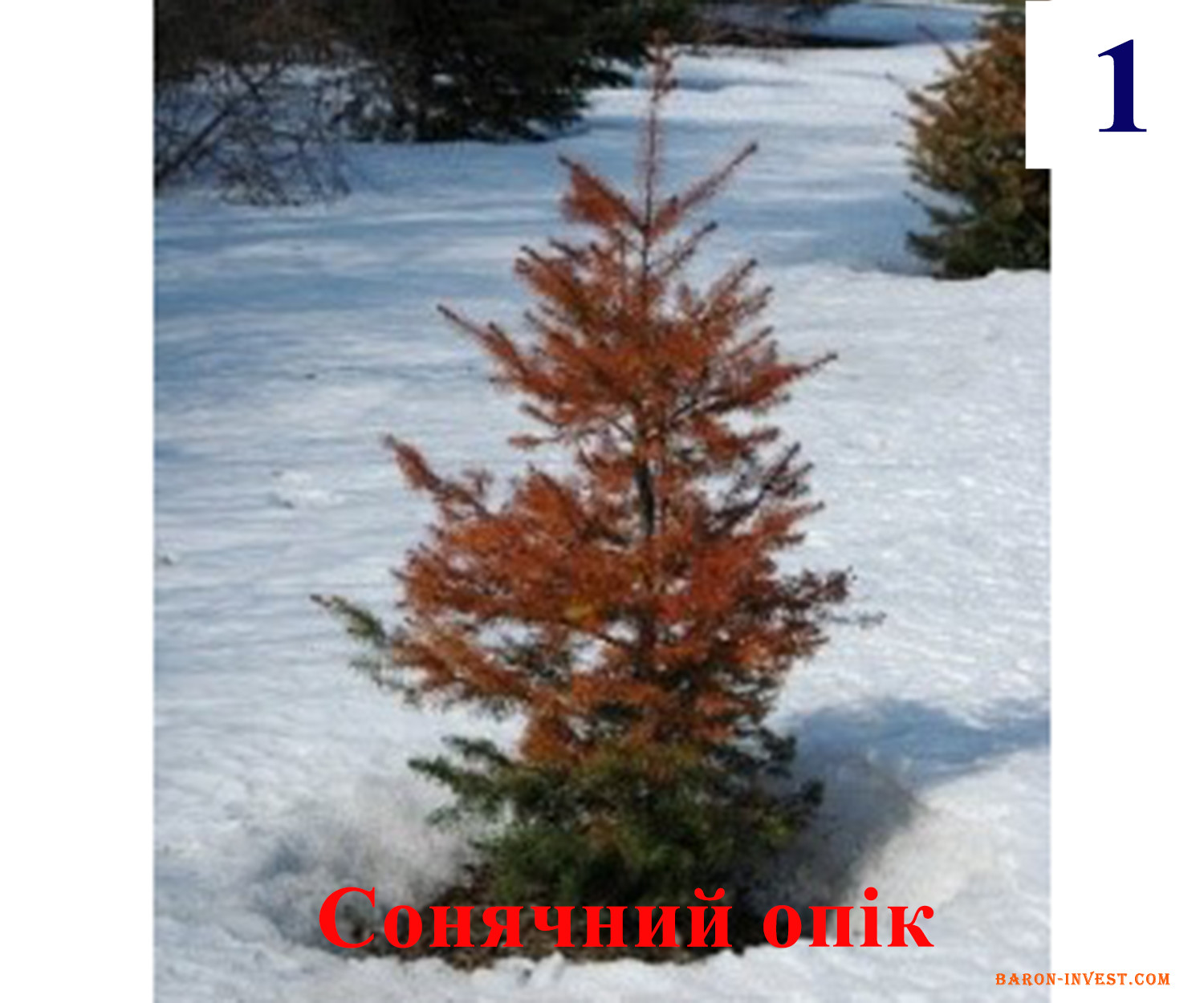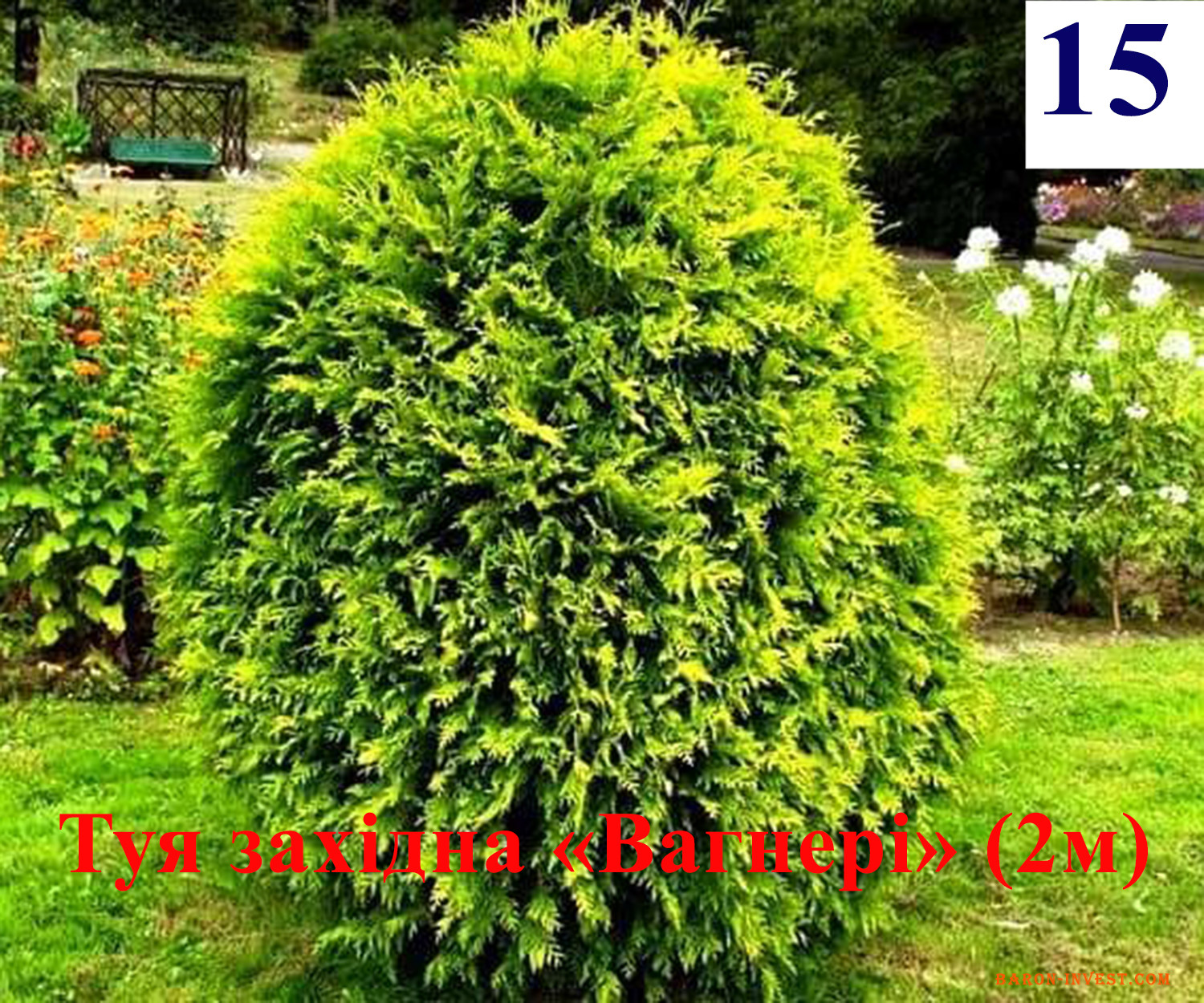ID 141957

Шкідники туї
ТОВ "БАРОН ІНВЕСТ"
Україна, Київська reg, Київ
25-09-2023
negotiable
ID 141956

Хвороби туї
ТОВ "БАРОН ІНВЕСТ"
Україна, Київська reg, Київ
25-09-2023
negotiable
ID 141955

Список сортів туї за величиною зростання до 2-х метрів
ТОВ "БАРОН ІНВЕСТ"
Україна, Київська reg, Київ
25-09-2023
negotiable
ID 141954

Список сортів туї за величиною зростання від 2-х метрів
ТОВ "БАРОН ІНВЕСТ"
Україна, Київська reg, Київ
25-09-2023
negotiable
Ads in the category
"THUJA"
Arborvitae (Thuja) is a genus of evergreen coniferous trees and shrubs belonging to the cypress family. There are five known species, which are native to Eastern Asia and North America. In our country, four species of arborvitae are cultivated for decorative purposes, with the most common being the species known as Western arborvitae (Thuja occidentalis L.), which can reach heights of up to 20 meters. This plant is highly frost-resistant, tolerates pollution and pruning well; its wood is lightweight and highly resistant to decay. Arborvitae is often cultivated in botanical gardens and parks throughout Ukraine.
The species of arborvitae include:
Korean Arborvitae (Thuja koraiensis).
Western Arborvitae (Thuja occidentalis).
Giant Arborvitae (Thuja plicata).
Japanese Arborvitae (Thuja standishii).
Sichuan Arborvitae (Thuja sutchuenensis).
Arborvitae in Landscape Design
In landscape design, arborvitae has long been an integral component alongside other coniferous trees. This is because this plant remains evergreen and can refresh the landscape at any time of the year. Additionally, it fills the air with a pleasant aroma, which is considered beneficial for certain health conditions.
Arborvitae can be used as a standalone element in mini-parks or gardens and also looks great on terraces. In landscape design, dwarf varieties of arborvitae are often used, complementing flowerbeds of various kinds. The shape of the arborvitae crown can be easily sculpted, making it suitable for almost any stylistic direction.
Arborvitae pairs well with deciduous plants, but it is not recommended to plant it near fir, pine, or spruce trees. However, it harmoniously coexists with other trees, such as birch and bird cherry.
This plant can be used for decorating pathways leading to entrances or creating walkways from gates. Arborvitae is ideal for hedges and zoning your property. It looks particularly striking next to artificial water features, but it's important to choose plants that will harmonize with it. Typically, arborvitae is planted to reinforce the shoreline.
Dwarf varieties of arborvitae complement small fountains, rocks, and stone terraces, and they can easily be combined with other plants in landscape design.
Planting and Caring for Thuja: Growing Thuja at Home
Planting and maintaining Thuja, also known as the arborvitae, in home conditions is a popular interest among landscape designers. Thuja offers the opportunity to create hedges and unique garden figures, becoming a true ornament to the garden.
In nature, Thuja can reach impressive sizes, up to 70 meters in height and 6 meters in trunk diameter. However, in cultivation, their height is limited to approximately 10-11 meters. Young plants have needle-like leaves that gradually become scale-like with age.
The advantages of Thuja include:
Low maintenance requirements.
Maintains its decorative appearance throughout the year.
Tolerates heat, drought, and cold.
Resistant to diseases and pest infestations.
Can grow in polluted urban air.
Emits a pleasant aroma and contributes to the elimination of harmful microorganisms.
Thuja comes in numerous species and varieties with different characteristics such as size, growth rate, crown shape, leaf color, and cultivation requirements. This allows gardeners to choose the optimal option for their garden. Among the wide selection of varieties, the most popular ones include Thuja Brabant, Thuja Emerald and Golden Emerald, Danica, Zebrina, and Cornic.
Planting Thuja
Many people wonder if they can plant Thuja in their yard due to various superstitions associated with this tree. Thuja symbolizes immortality and a vivid memory and is often planted near graves. However, besides negative beliefs, there are positive ones.
Thuja is also called the "tree of life" because it:
Protects the inhabitants of the house from negative energy, malicious influence, and negative forces.
Repels evil spirits and unfriendly individuals.
Helps uncover cunning schemes and intrigues.
Promotes the development of talents and the expression of individuality.
Ensures the protection of family happiness.
If you still decide to plant Thuja in your yard, it is recommended to choose a dwarf variety. It is believed that negative influences only work if the tree grows taller than your house.
When is the best time to plant Thuja seedlings?
Thuja can be planted at any time, except during the winter period. Experienced gardeners recommend planting Thuja preferably in the spring to give it enough time to adapt to its surroundings and establish good root growth before winter. However, in regions with a hot climate, it's advisable to plant Thuja in the fall.
Spring planting should begin after the soil has warmed up and should be completed before the trees start leafing out. Fall planting is recommended after the start of November but before the onset of frost. It's important for the daytime air temperature not to exceed 20 degrees Celsius and for the nighttime temperature not to drop below 10 degrees Celsius.
Choosing a location for Thuja planting
Before planting Thuja, it's essential to select a location that offers some protection from direct sunlight and strong winds, which can be detrimental to the plant. Direct sunlight can cause Thuja to wilt, while insufficient sunlight can lead to a loss of color vibrancy.
Thuja can grow in various types of soil, but the best decorative effect is achieved in soil that contains loam, sand, and peat. It's important for the soil to be weakly or neutrally acidic. If the soil is too alkaline, you can add coniferous needles, leaf compost, peat, or sawdust to raise its acidity to the desired level.
The Planting Process
The planting of thuja is carried out in several stages:
Dig a hole that is one meter deep and wide enough to accommodate the root system.
Spread wood ash at the bottom of the hole, mixing it with the soil.
Place the seedling in the hole, making sure that the root collar is level with or slightly above the soil surface.
Fill the remaining space in the hole with soil mixed with peat and sand in the appropriate proportions.
Compact the soil.
Water the seedling thoroughly.
This method is suitable for seedlings with a closed root system. In the case of an open root system, the seedling should be placed in cool water before planting, and it should remain there until no more air bubbles are released. The roots should be treated with root growth stimulants (heteroauxin, rooting powder), and the crown should be treated with anti-stress agents (epin, amber acid).
If planting is done in the spring, fertilizer should be added to the hole, but this is not necessary in the fall. In cases of excessive moisture in the soil, drainage should be added to the hole to prevent root rot.
As for the distance between thuja plants, it depends on their size and the purpose of planting. For small shrubs, leave a one-meter gap. However, if you are planting tall varieties like Thuja Smaragd, maintain a distance of 4-5 meters. If you are creating green corridors or live hedges, seedlings of any variety should be planted one meter apart from each other.
You can see what a beautiful thuja planting looks like in the photos.
Caring for thuja trees in your own garden involves the following aspects:
Regular watering of the plants.
Daily leaf moistening.
Two prohibited feedings during the season.
Weeding from time to time.
Using mulch.
Regular pruning to maintain the shape of the thuja.
Growing and maintaining thuja in home conditions doesn't require significant effort or time but can add a special style and charm to your property.
How to Prepare Coniferous Trees for Winter?
Taking care of thuja trees in the fall includes mandatory watering, as the plant's development, albeit slower, continues during the winter.
During the first five years of planting, it's important to provide them with warmth. For this purpose, they are covered with special wraps, which can be made from non-woven materials or polyethylene film, creating a cozy cocoon. The roots are covered with fallen leaves.
When starting spring care for thuja trees, it's necessary to remove the fallen leaves. However, it's best done on a cloudy day to avoid root burns.
Plant Description
Definition - What is "Thuja"
Thuja is a genus of trees and shrubs belonging to the cypress family. They are known for their ability to retain their green foliage throughout the year and are used as decorative plants in gardens and landscape design.
Classification
Thuja belongs to the cypress family (Cupressaceae) and the genus Thuja.
Number of Species
There are approximately five species of thuja in the world, but the most well-known ones are Thuja occidentalis (Eastern Arborvitae) and Thuja orientalis (Oriental Arborvitae).
Sunlight Preference
Thuja prefers sunny or partially shaded locations. It can grow in full sun, but it also thrives under light shade.
Tolerance to Shade
Thuja is fairly tolerant of shade, but the best growth is observed in sunny areas or under light partial shade.
Drought Tolerance
Thuja is a moisture-loving plant and can withstand short periods of drought. However, for healthy growth and development, it requires regular watering.
Avoiding Waterlogging
Thuja does not tolerate waterlogging, especially during the winter months. Excess moisture can lead to root rot.
Flowering Period
Thuja rarely flowers, and its flowers are not visible or decorative elements. It is an ornamental coniferous plant with green branches as its main adornment.
Soil Requirements and pH
Thuja thrives on well-drained soils with a slightly acidic pH (pH 6-7). It's important to avoid water stagnation, as it can lead to root rot.
Planting Instructions, Root Collar, and Preferred Locations
When planting thuja, it's essential to keep the root collar level with the soil surface. Thuja is often used in hedges, and the distance between plants should be approximately 1-3 meters.
Spring Care, Including Fertilization
In spring, it is recommended to prune to shape the shrub or tree. You can also apply a complex mineral fertilizer with a spring formula for plant nutrition.
Summer Care, Including Fertilization
During summer, it's important to regularly water thuja during hot weather and ensure it has sufficient moisture. Fertilization can be done as needed, but avoid excessive application.
Autumn Care, Including Fertilization
Autumn is the time to check the plant's condition and prepare it for winter. Fertilization is not mandatory, but it's essential to resume watering after the summer heat.
Winter Care, Including Fertilization
In winter, thuja is dormant and does not require active care or fertilization. Protection from frost can be beneficial for young plants. Withstands -30 degrees above zero.
Pruning
Pruning is used to shape thuja into the desired form, remove dead branches, and maintain a healthy plant.
